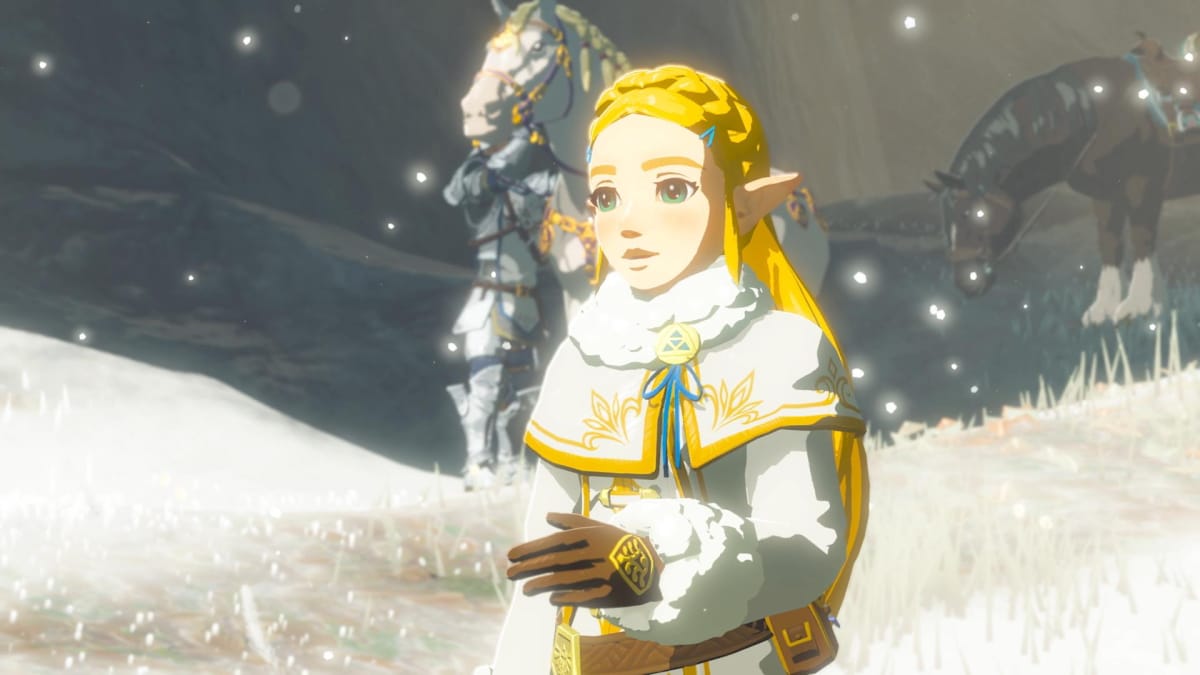As we near the 35th anniversary of The Legend of Zelda, now is the perfect time to reflect on the journey the Princess of Hyrule herself has gone through. There have been numerous games in the series and a variety of incarnations of the character, so why not have a look back at her development highlights throughout the series to appreciate the real changes that have occurred?
From Princess to Sheik
Let’s start with the original: The Legend of Zelda for the Nintendo Entertainment System and its direct sequel, Zelda II: The Adventure of Link. In the first game, we learn the origin story of the series, the Triforce, and the land of Hyrule. Most importantly, we meet the holder of the Triforce, Princess Zelda, and learn of her decision to split it into three pieces and hide them across the land. In the early entries of the franchise, Princess Zelda serves a singular purpose, which is to be saved by the hero. Zelda II has a similar storyline of Zelda’s evil brother wanting to collect all the pieces for himself, putting Zelda under a sleeping spell; again she needs to be saved. It is important to keep in mind that this was before character development was a huge necessity for video games, and there were hardly any female protagonists.

When The Legend of Zelda series made the jump to the Super Nintendo Entertainment System in 1992 with A Link to the Past, it seemed as though things remained the same. The opening of the game has Zelda following Link around her own castle while under attack. In true damsel-in-distress fashion, she doesn't even try to defend herself and relies on being saved. While this still may have been the norm around this time, we were starting to see female characters take a more prominent role in video games, such as Samus in Metroid, Paula in Earthbound, or Lucca in Chrono Trigger. Afterwards came The Legend of Zelda: Link’s Awakening in 1993 on Game Boy, which did not even have her as a character; she was only mentioned by name.
In 1998, a little game titled The Legend of Zelda: Ocarina of Time was released for the Nintendo 64, and we finally began to see Princess Zelda as a character rather than just a princess. Ocarina of Time is often considered one of the best video games to this day, having showcased the new 3D graphics of the N64 as well as the new direction the series was taking. At the start of the game, we see a young Princess Zelda and her dream sequence. She quickly has to flee Hyrule Castle with her bodyguard Impa as Ganondorf attempts to enact his evil plan and steal the Triforce from the royal family. As she flees, she leaves Link with the titular ocarina and a message that she will need his help in the future. Fast forward seven years later, and Link is able to travel through time via the Temple of Time. He is greeted by a stranger named Sheik, a mysterious man from the Sheikah tribe. Sheik tells Link that Ganondorf has taken over the entire land of Hyrule in his absence. In order to defeat Ganondorf, Link needs to free the sages and learn how to overpower him—a task Sheik helps with every step of the way. It isn’t until this quest comes to an end that we learn Sheik is in fact the princess in disguise, having taken a much stronger and more daring approach to saving Hyrule than we had ever seen in the past.

The Beginning of Her Transformation
Following that, Wind Waker was released with a completely new style from previous games and takes place in a different timeline. Link encounters Tetra, a sassy pirate who is the only female in a band of pirates. He helps Tetra escape from a large bird on his home island, to which she returns the favor by helping Link save his sister from the Helmaroc King. Later on in the game, Tetra and her crew come to save Link while he is battling against Ganondorf in the Forsaken Fortress. While unsuccessful, the pair travel to the sunken Hyrule Castle to see Daphnes Nohansen Hyrule, where he reveals that the necklace Tetra has been wearing (a gift from her mother) is actually the Triforce of Wisdom, and the king reveals Tetra’s true identity as Princess Zelda.

Afterwards, Link leaves to search for the last piece of the Triforce but soon returns to Hyrule Castle to learn that Zelda has been kidnapped by Ganondorf. During the long battle, Princess Zelda herself picked up Link’s bow and arrow to aid him. Ganondorf knocks her down, but she is able to get back up. She changes her tactic and instead aims the arrow at Link’s mirror shield so that he can deflect it to Ganondorf and eventually defeat him. There are mixed feelings in Wind Waker; on the one hand, she is a sassy pirate who answers to know one. However, the game takes a step back by having Princess Zelda get captured again. It seems as though Nintendo was testing the waters with the idea of Zelda being her own character but ultimately plays it very safe by falling back on old habits.
At the beginning of Twilight Princess we don’t see much progress from Princess Zelda’s development. Similar to older entries, she relies on Link to rescue her. However, there is a moment where she takes action in the game and sacrifices herself to save Link’s companion of the Twilight Realm, Midna. Towards the end of the game, Ganondorf possesses a lifeless Princess Zelda and turns her into a puppet, forcing Link and Midna to defeat her and bring her back to life. Zelda is then protected by the Light Spirits which grant her light arrows to aid Link in the battle. She even gets on Link’s horse to aid him.
This shows again that Nintendo tries to give Princess Zelda some sort of character development but yet again relies on the “damsel in distress” trope. Midna is a breath of fresh air in the franchise. She’s a princess as well, but she shares equal amount of screentime as Link in this game and it is a much more dynamic partnership. She is critical to the plot and helps Link through the game. While the strong female character of Midna is greatly appreciated, our Princess Zelda could use some of that energy.

In Skyward Sword, Zelda is no longer a princess at all (most likely because this is canonically the beginning of the timeline and the repeating prophecy hasn’t begun yet) but is Link’s best friend. True, she does eventually need to be saved and fits back into the damsel narrative, but she is far more humanized as your friend rather than a member of the royal family. She isn’t portrayed as being above you in any way. Her importance comes from the Goddess Hylia choosing to essentially possess Zelda, knowing that Link—someone virtuous enough to wield the Triforce—would protect Zelda’s mortal form at any cost. The game tiptoes around a more personal version of Zelda but still keeps her in that “damsel” category for the sake of narrative.
From Ruler to Savior and What Lies Ahead
Lastly, we reach Breath of the Wild; our Princess Zelda is fully realized in this game. Gone is the “damsel in distress” trope, and in its place is a complex character struggling to find herself amongst the pressures of being born into royalty and a kingdom thrown into chaos. She takes it upon herself to learn about the ancient Guardians and different flora of Hyrule, but struggles with being herself. There is a truly heartbreaking cutscene in which her own father confronts her about how she is not living up to the expectations of anyone, how people are gossiping about her, and she is wasting her time doing research on things. It shows on Zelda instantly—she is angry and frustrated—to have her own father say that she is letting him down. Link is given the task of being Zelda’s knight/protector as they travel, but Zelda later tells Link to stop following her, allowing her to go on her own journey. She does get herself into some trouble with a Yiga assassin in which Link appears and saves her.

This is not a “damsel in distress” situation, just Link staying true to his character and duties to protect her. Seeing his loyalty and kindness allows Zelda to open up to Link, and their relationship grows as they spend time together. This helps Zelda awaken her powers in time. Instead of having someone save her, she digs deep to find her inner strength. During one of her lowest moments, aggressive Guardians are closing in on her and a gravely weakened Link, and she raises her hand to stop them. It is truly at this moment we realize that Princess Zelda is so much more of a dynamic, complex character now. She has found her voice and she is using it, controlling her own destiny. Breath of the Wild has allowed Zelda to become a strong, confident leader. While she still needs to be saved, she hasn’t just been captured like previous games and is actively defending the land against Ganon.
Over The Legend of Zelda’s 35 years, we have seen Princess Zelda become a real character. In the beginning, she was the token princess that needed saving. It wasn’t until Ocarina of Time where we started to see Zelda take action and participate in the story. Twilight Princess and Skyward Sword furthered the idea of Princess Zelda becoming more than a plot device. By Breath of the Wild, she has grown into her own character: complex, strong, and determined. With the sequel to Breath of the Wild announced, we can only hope that Nintendo continues to allow Princess Zelda to evolve and possibly lead her own story. It is easy to say that over the course of 35 years, Princess Zelda has gone from damsel to defender.
Have a tip, or want to point out something we missed? Leave a Comment or e-mail us at tips@techraptor.net













